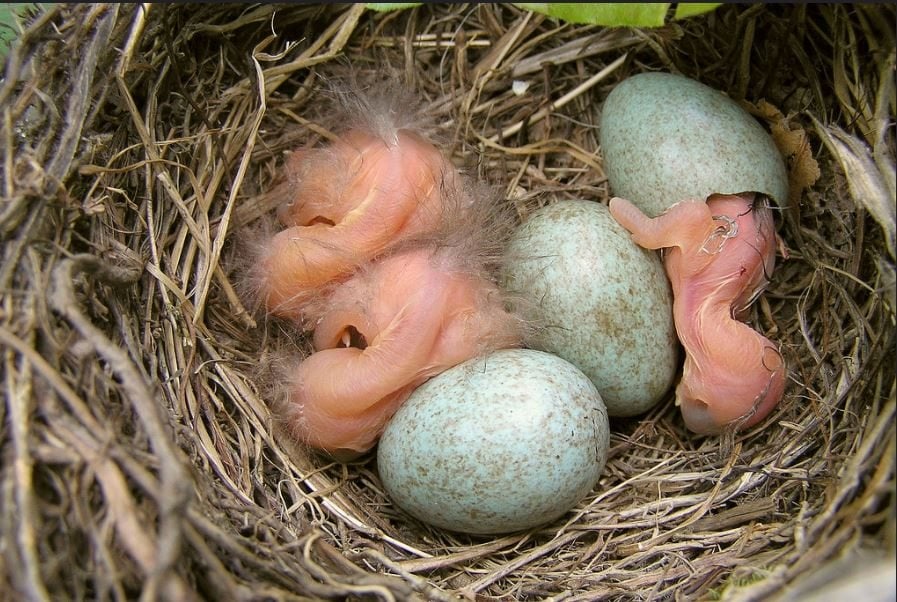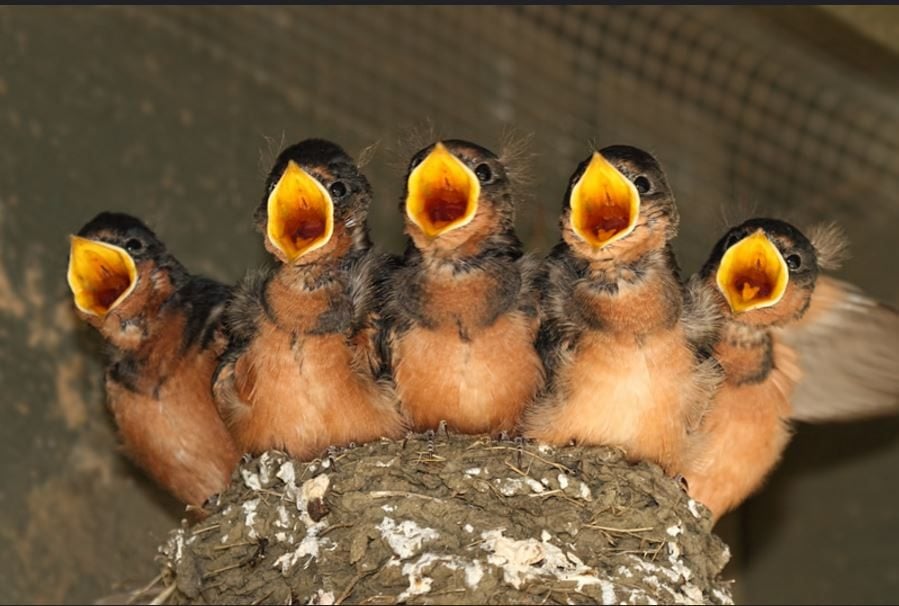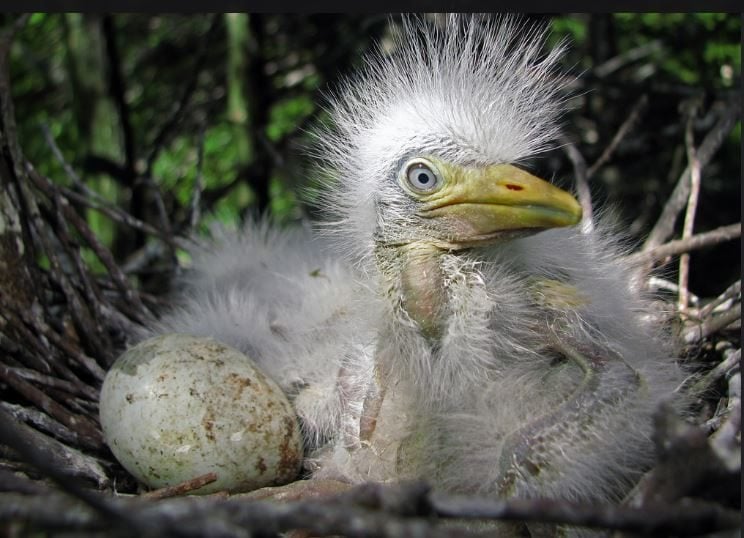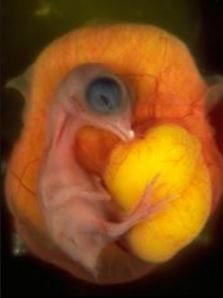Hatching strategies – when and why?
By Daryl Anne Goldman
It’s breeding season — an opportunity for birders to watch courtship rituals, nest building, eggs hatching, and parents caring for their chicks. It’s fascinating how much diversity there is among species in the number of eggs in a clutch, what the newly hatched chicks look like, and how dependent or mobile chicks are after hatching.
Did you ever wonder why the eggs of songbirds and owls hatch up to several days apart, while a clutch of duck eggs hatches within a few hours of each other? Why do duck eggs hatch within four hours when they are laid over the course of several days? These questions got me wondering about the parental contributions to this process, and whether the embryos do anything to directly influence this.
With a little research I learned that here are two types of hatching strategies — asynchronous and synchronous.
Asynchronous hatching
Asynchronous hatching is when the eggs of a clutch hatch over a period of a few days. The time between the first and last egg hatching can be as much as 14 days, as with the Barn Owl. With this hatching strategy, incubation usually starts before the later eggs are laid. There is a higher rate of mortality with this hatching strategy, and the last chick is usually not expected to survive and is more of an insurance policy against the loss of the first offspring. It’s much like the British monarchy: You need an heir and a spare. In some species the firstborn, stronger chicks or even the parents may push the weaker, last born chicks out of the nest.

What are the parental contributions to asynchronous hatching? The female deposits differing amounts of hormones, immunoglobulins, and antioxidants in the yolk, albumen, and shells of the eggs she lays, which then affects the survival of each hatchling. For instance, in some species yolk antioxidant and immunoglobulin concentrations may decrease across laying order, thus handicapping the immune system of the last hatched chicks. However, in the same species, yolk testosterone concentrations may increase with laying order, which may compensate for poorer immune function by helping accelerate growth and food begging rates.
Does the embryo have a role? There is some research showing that bird embryos can actively modify the action of the hormones deposited in the yolk, and use maternal steroids to benefit their own fitness. Interesting work has been done with European Starlings, but more research is needed.
What are the evolutionary benefits of asynchronous hatching? The oldest theory, proposed by David Lack in 1947, is that it is a form of selective brood reduction for when food resources are scarce. When supplies are short, food will be allocated to the strongest chicks. Another theory is that females may prolong the time between laying each egg as a way to provide each egg with sufficient nutrients, as they themselves become depleted from egg laying and need to replenish their own stores.
Some posit that asynchronous hatching decreases loss from predation because it reduces the amount of time that the whole brood is in the nest at the same time. Others suggest that having eggs hatch over a period of time allows parents to take advantage of unpredictable, rapidly peaking food resources like insect eruptions. And finally, some believe that it may be a way to reduce “peak energy load” or the amount of time that parents have to care for all the chicks at the same time.
While many human parents might vote for the last theory, the jury is still out on the purpose of asynchronous hatching.

So which species use an asynchronous hatching strategy? They are most likely to be altricial and semialtricial birds, although there are some exceptions.[i]
Altricial birds are those whose chicks are born naked with closed eyes. They are nestbound for weeks, totally dependent on their parents for food, and need parental attendance for survival. Think songbirds and woodpeckers. “Semialtricial 2” birds are similar to altricial birds, except they are born covered with down, not naked. Most owls belong in the semialtricial 2 category.


Synchronous hatching
Synchronous hatching is when the eggs in the clutch are born within a few hours of each other even though they have been laid days apart. With this strategy, incubation does not usually start until all the eggs are laid. The exceptions to this rule are waterfowl, which may sit on the first eggs they lay without applying heat because their brood patch is not fully developed, or may start incubating the first eggs at a lower temperature (one to three degrees cooler). Broods tend to be larger and there is a higher rate of survival with this hatching strategy.
Synchronous hatching is most common in precocial and some subprecocial and semiprecocial birds. Precocial birds — such as ducks, shorebirds, quail and grouse — are born covered in down, eyes open, can leave the nest right away and can feed themselves with parental guidance. There’s strength in numbers and we’ve all seen newly hatched ducklings trailing after an adult, learning how to search out food and heeding warnings about danger. Grebes, loons, quail, and cranes fall into the category of subprecocial because they are similar to precocial in every way, except they require a little more help from their parents when it comes to feeding. Semiprecocial birds like gulls, terns, auks, and penguins are born covered in down, eyes open, but do not stray far from the nest for a period of time and require parental feeding and attendance.

Synchronous hatching is important for precocial and subprecocial birds because they can wander off shortly after they are born, and if the parents are still brooding the later eggs they could easily be a nice dinner for a hawk.
One example of synchronous hatching in the Canada Goose. The female lays three to nine eggs up to 36 hours apart, with incubation starting after the third egg is laid. The heat applied to these first three eggs is one to three degrees cooler than the heat applied once the clutch is complete. Total incubation time among the eggs can differ by as much as 10 days, yet all the eggs hatch within 24 hours of each other.


Earlier I mentioned how avian mothers in altricial species deposit differing amounts of nutrients into each egg. The precocial females also deposit varying amounts of hormones, carotenoids, vitamin E, immunoglobulin, RNA transcripts, and other genetic material in the yolk, albumen, and eggshells of each egg. Which eggs receive the most nutrients varies among species, but in general, the last-laid eggs of precocial birds receive a higher proportion of nutrients and have thicker shells, higher shell conductance, greater weight, and a higher metabolism. This allows the later-laid eggs to achieve faster growth.

What is the role of the embryos in synchronous hatching? This is my favorite part of all of this. In 1969, M.A. Vince showed that the embryos of precocial birds produce clicking sounds that speed up metabolism in the later-laid eggs and this contributes to the synchronization of hatching. Clicking starts two days before hatching, with the onset of respiration. It begins when the embryo pierces the inner membrane of the egg, and the rate of clicking increases until the outer shell is penetrated.
It used to be believed that this clicking sound was the embryo’s egg tooth tapping on the shell, bill clapping, or a vocalization controlled by the syrinx. Vince was able to prove that the clicks are produced synchronously with respiration movements, and like respiration rate, clicking rate depends on temperature. Clicks are short and have a wide range of frequencies across species.
Synchronous hatching starts when the second member in the clutch starts to click. Each embryo adapts their clicking rate to match the others and they form a common rhythm. In Muscovy Duck this takes only one minute to achieve. After embryos achieve a 1:1 synchronization of clicking, the rate increases. Clicking rate decreases close to hatching.
You may be curious about when birds develop hearing, and whether they can even hear these clicks. The onset of hearing is in the last half of incubation for precocial birds and the last third of incubation for semialtricial birds. (Up until 2012 it was believed that altricial birds did not develop hearing until after hatching, but Colombelli-Negrel’s work with Superb Fairy Wrens shows that this altricial bird does develop hearing before it hatches.)
So how are we sure that clicking really does affect synchronization of hatching? Research where embryos were prevented from hearing their own clicking, with the application of 80 db of noise, took an average of four times longer to hatch. Also, researchers found that stimulation with artificial clicking rates can shorten or lengthen incubation time when applied during the critical period of clicking.
Do embryonic vocalizations using the syrinx affect the hatching process? Species specific vocalizations of ascending and descending frequencies also develop when the embryo pierces the inner membrane of the egg. These appear to be comfort and distress calls, playing an important role in stimulating parents to maintain egg temperature, but they do NOT affect synchronization of hatching.
Neither have parental calls been shown to have an effect on synchronization of hatching. In fact, vocalizations of the female on the nest remained constant and were always connected with the behavior of egg turning. It seems that acoustic interactions between the breeding parent and chicks do not start to develop until the chicks start to emerge from the egg.
Other than measuring vocal responses and clicking, it is actually difficult to study what precocial embryos hear and learn because precocial birds are not a vocal learning species. There is some very exciting research now by Colombelli-Negrel (Australia) and her colleagues who are studying auditory discrimination and learning in the embryos of the Superb Fairy-Wren and Red-backed Fairy-Wren. It makes more sense to study auditory discrimination in altricial species, like these wrens, because they are auditory learners.
Daryl Anne Goldman is a clinical psychologist who believes that anyone can find happiness and meaning by becoming a birder. She took part in the 2016 year-long Master Birder class co-sponsored by Golden Gate Bird Alliance and California Academy of Sciences. This is adapted from her class presentation for the Master Birder Program.
Footnote
[i] All of the studies I found on hatching strategies, with the exception of one article, agree that hatching style is directly related to the species’ classification along the precocial / altricial continuum. Marion Rumpf and Barbara Tzchentke studied 86 bird species with a synchronization scale they developed, and found that there are exceptions to this widely believed rule, and suggested that more altricial bird species need to be studied. They found that altricial birds such as the Eurasian Skylark, Common Kingfisher, Common Chiffchaff and Woodlark have a synchronous hatching style. The Japanese White-eye has a 3:1 hatching style, i.e. the first three eggs hatch very close together and the fourth hatches days later.
References
Brua, RB. 2002. Parent-offspring interactions. In Deeming DC, editor. Avian incubation behavior, environment and evolution. Oxford UK: Oxford University Press. p 88-99.
Colombelli-Negrel D, Hauber ME, Robertson J, Sulloway FJ, Hoi H, Griggio M, Leindorfer S. 2012. Embryonic learning of vocal passwords in Superb Fairy-Wrens reveals intruder Cuckoo nestlings. Curr Biol. 22: 1-6.
Reed WL, Clark ME. 2011. Beyond maternal effects in birds: Responses of the embryo to the environment. Integr Comp Biol. Doi: 10.1093/icb/icr032.
Rumpf M, Tzschentke B. 2010. Perinatal acoustic communication in birds: Why do birds vocalize in the egg? Open Ornith. J. 3:141-149.
Rumpf M, Tszchentke B. 1992. Hatching synchronization in birds. WPSA Working Group 6 (Reproduction): 2010 Meeting.
Vince MA. 1969. Embryonic communication, respiration and synchronization. In: Hinds RA. Editor. Bird vocalization. Cambridge: Cambridge University Press. p 233-260.
